Effect of Textural Features in Remote Sensed Data on Rubber Plantation Extraction at Different Levels of Spatial Resolution
Abstract
:1. Introduction
2. Materials and Methods
2.1. Study Area
2.2. Datasets and Pre-Processing
2.2.1. Sentinel-1
2.2.2. GaoFen-1
2.2.3. Sentinel-2
2.2.4. Landsat 8
2.2.5. Field Survey Data and Sample Datasets
2.3. Texture Processing
2.4. Random Forest Classification
2.4.1. Forests Mapping
2.4.2. Feature Importance Measure
2.4.3. Rubber Plantation Extraction Using GF-1, Sentinel-2, and Landsat 8 Data
3. Results
3.1. Forest Mapping and Accuracy Assessment
3.2. The Optimal Window Sizes for Textures Calculation
3.3. The Importance Sorting of Textural Features for GF-1, Sentinel-2, and Landsat 8
3.4. Classification Results Using GF-1, Sentinel-2, and Landsat 8 Data
4. Discussion
4.1. The Optimal Window Sizes for Textural Features Calculation
4.2. Contribution of Textural Features on Rubber Plantation Delineation
4.3. Applicability of Remote Sensing Data at Different Resolutions to Rubber Plantation Extraction
5. Conclusions
- (1)
- The higher the resolution, the larger the window size needed. The resultant window size for extracting eight textural features from GF-1 images is 31 × 31. For Sentinel-2, the window sizes are 15 × 15 for MEAN and VAR, 13 × 13 for HOM, CON, ENT, ASM, and COR, and 11 × 11 for DIS. For Landsat 8, the textural feature calculation window sizes of MEAN, ENT, and ASM are 3 × 3, 5 × 5 for CON and DIS, and 7 × 7 for HOM, VAR and COR.
- (2)
- The Random Forest importance measures show that MEAN, VAR, ENT, and COR were important for GF-1 classification, while HOM, ENT, ASM, and COR were chosen for Sentinel-2 classification. MEAN, HOM, CON, and COR had more influence in the separation of rubber plantations and natural forests for Landsat 8.
- (3)
- The importance of COR was always in the top three among the eight textural features in GF-1, Sentinel-2, and Landsat 8, so COR is a robust textural feature in three different resolutions when distinguishing rubber plantations from natural forests.
- (4)
- Adding textural features as additional inputs improved the overall accuracy and the producer’s and user’s accuracies compared to using spectral features only for rubber plantation classification. With the help of textural features, the 10 m Sentinel-2 imagery could accurately extract rubber plantations with the producer’s accuracy reaching 91.26% and the user’s accuracy reaching 96.67%. Meanwhile, the 2 m GF-1 imagery underestimated rubber plantations with a producer’s accuracy of 87.41% and a user’s accuracy of 97.28%, and the rubber plantation area was overestimated by the 30 m Landsat 8 imagery with a user’s accuracy of 96.59% and a producer’s accuracy of 89.16%. Compared with GF-1, the higher accuracies of the Sentinel-2 and Landsat 8 sensors may be attributed to the SWIR band.
Author Contributions
Funding
Conflicts of Interest
References
- Payn, T.; Carnus, J.-M.; Freer-Smith, P.; Kimberley, M.; Kollert, W.; Liu, S.; Orazio, C.; Rodriguez, L.; Silva, L.N.; Wingfield, M.J. Changes in planted forests and future global implications. For. Ecol. Manag. 2015, 352, 57–67. [Google Scholar] [CrossRef] [Green Version]
- FAO. Global Forest Resources Assessment 2015: How Have the World’s Forests Changed? Food and Agriculture Organization of the United Nations (FAO): Rome, Italy, 2015. [Google Scholar]
- Buongiorno, J.; Zhu, S. Assessing the impact of planted forests on the global forest economy. New Zealand J. For. Sci. 2014, 44, S2. [Google Scholar] [CrossRef] [Green Version]
- Foley, J.A.; DeFries, R.; Asner, G.P.; Barford, C.; Bonan, G.; Carpenter, S.R.; Chapin, F.S.; Coe, M.T.; Daily, G.C.; Gibbs, H.K.; et al. Snyder. Global Consequences of Land Use. Science 2005, 309, 570–574. [Google Scholar] [CrossRef] [Green Version]
- Ziegler, A.D.; Fox, J.M.; Xu, J. The rubber juggernaut. Science 2009, 324, 1024–1025. [Google Scholar] [CrossRef] [PubMed]
- Hurni, K.; Fox, J. The expansion of tree-based boom crops in mainland Southeast Asia. J. Land Use Sci. 2018, 13, 198–219. [Google Scholar] [CrossRef]
- Dong, J.; Xiao, X.; Chen, B.; Torbick, N.; Jin, C.; Zhang, G.; Biradar, C. Mapping deciduous rubber plantations through integration of PALSAR and multi-temporal Landsat imagery. Remote Sens. Environ. 2013, 134, 392–402. [Google Scholar] [CrossRef]
- Friedl, M.A.; Sulla-Menashe, D.; Tan, B.; Schneider, A.; Ramankutty, N.; Sibley, A.; Huang, X. MODIS Collection 5 global land cover: Algorithm refinements and characterization of new datasets. Remote Sens. Environ. 2010, 114, 168–182. [Google Scholar] [CrossRef]
- Torbick, N.; Ledoux, L.; Salas, W.; Zhao, M. Regional mapping of plantation extent using multisensor imagery. Remote Sens. 2016, 8, 236. [Google Scholar] [CrossRef] [Green Version]
- Chen, D.; Stow, D.A.; Gong, P. Examining the effect of spatial resolution and texture window size on classification accuracy: An urban environment case. Int. J. Remote Sens. 2004, 25, 2177–2192. [Google Scholar] [CrossRef]
- Chatziantoniou, A.; Psomiadis, E.; Petropoulos, G.P. Co-Orbital Sentinel 1 and 2 for LULC mapping with emphasis on wetlands in a mediterranean setting based on machine learning. Remote Sens. 2017, 9, 1259. [Google Scholar] [CrossRef] [Green Version]
- Zhu, J.; Pan, Z.; Wang, H.; Huang, P.; Sun, J.; Qin, F.; Liu, Z. An Improved Multi-temporal and Multi-feature Tea Plantation Identification Method Using Sentinel-2 Imagery. Sensors 2019, 19, 2087. [Google Scholar] [CrossRef] [PubMed] [Green Version]
- Wang, L.; Zhang, S. Incorporation of texture information in a SVM method for classifying salt cedar in western China. Remote Sens. Lett. 2014, 5, 501–510. [Google Scholar] [CrossRef]
- Marceau, D.J.; Howarth, P.J.; Dubois, J.-M.M.; Gratton, D.J. Evaluation of the grey-level co-occurrence matrix method for land-cover classification using SPOT imagery. IEEE Trans. Geosci. Remote Sens. 1990, 28, 513–519. [Google Scholar] [CrossRef]
- Lu, D.; Batistella, M.; Li, G.; Moran, E.; Hetrick, S.; Freitas, C.d.C.; Dutra, L.V.; Sant’Anna, S.J.S. Land use/cover classification in the Brazilian Amazon using satellite images. Pesqui. Agropecuária Bras. 2012, 47, 1185–1208. [Google Scholar] [CrossRef]
- Dian, Y.; Li, Z.; Pang, Y. Spectral and Texture Features Combined for Forest Tree species Classification with Airborne Hyperspectral Imagery. J. Indian Soc. Remote Sens. 2015, 43, 101–107. [Google Scholar] [CrossRef]
- Agüera, F.; Aguilar, F.J.; Aguilar, M.A. Using texture analysis to improve per-pixel classification of very high resolution images for mapping plastic greenhouses. ISPRS J. Photogramm. Remote Sens. 2008, 63, 635–646. [Google Scholar] [CrossRef]
- Ferreira, M.P.; Wagner, F.H.; Aragão, L.E.; Shimabukuro, Y.E.; de Souza Filho, C.R. Tree species classification in tropical forests using visible to shortwave infrared WorldView-3 images and texture analysis. ISPRS J. Photogramm. Remote Sens. 2019, 149, 119–131. [Google Scholar] [CrossRef]
- Woodcock, C.E.; Strahler, A.H. The factor of scale in remote sensing. Remote Sens. Environ. 1987, 21, 311–332. [Google Scholar] [CrossRef]
- Li, Z.; Fox, J.M. Mapping rubber tree growth in mainland Southeast Asia using time-series MODIS 250 m NDVI and statistical data. Appl. Geogr. 2012, 32, 420–432. [Google Scholar] [CrossRef]
- Fox, J.; Castella, J.-C. Expansion of rubber (Hevea brasiliensis) in Mainland Southeast Asia: What are the prospects for smallholders? J. Peasant Stud. 2013, 40, 155–170. [Google Scholar] [CrossRef]
- Gorelick, N.; Hancher, M.; Dixon, M.; Ilyushchenko, S.; Thau, D.; Moore, R. Google Earth Engine: Planetary-scale geospatial analysis for everyone. Remote Sens. Environ. 2017, 202, 18–27. [Google Scholar] [CrossRef]
- Veci, L.; Lu, J.; Prats-Iraola, P.; Scheiber, R.; Collard, F.; Fomferra, N.; Engdahl, M. The Sentinel-1 Toolbox. In Proceedings of the IEEE International Geoscience and Remote Sensing Symposium (IGARSS), Quebec, QC, Canada, 13–18 July 2014. [Google Scholar]
- Maurer, T. How to pan-sharpen images using the Gram-Schmidt pan-sharpen method—A recipe. Int. Arch. Photogramm. Remote Sens. Spat. Inf. Sci. 2013, 1, W1. [Google Scholar] [CrossRef] [Green Version]
- Zuhlke, M.; Fomferra, N.; Brockmann, C.; Peters, M.; Veci, L.; Malik, J.; Regner, P. SNAP (sentinel application platform) and the ESA sentinel 3 toolbox. In Proceedings of the Sentinel-3 for Science Workshop, Venice, Italy, 2–5 June 2015. [Google Scholar]
- Haralick, R.M. Statistical and structural approaches to texture. Proc. IEEE 1979, 67, 786–804. [Google Scholar] [CrossRef]
- Berberoğlu, S.; Akin, A.; Atkinson, P.M.; Curran, P.J. Utilizing image texture to detect land-cover change in Mediterranean coastal wetlands. Int. J. Remote Sens. 2010, 31, 2793–2815. [Google Scholar] [CrossRef] [Green Version]
- Howley, T.; Madden, M.G.; O’Connell, M.-L.; Ryder, A.G. The effect of principal component analysis on machine learning accuracy with high dimensional spectral data. In Applications and Innovations in Intelligent Systems XIII, Proceedings of the International Conference on Innovative Techniques and Applications of Artificial Intelligence, Cambridge, UK, 12–14 December 2005; Springer: Berlin, Germany, 2005. [Google Scholar]
- Breiman, L. Random Forests. Mach. Learn. 2001, 45, 5–32. [Google Scholar] [CrossRef] [Green Version]
- Dostálová, A.; Hollaus, M.; Milenković, M.; Wagner, W. Forest area derivation from sentinel-1 data. ISPRS Ann. Photogramm. Remote Sens. Spat. Inf. Sci. 2016, 3, 227. [Google Scholar] [CrossRef]
- Kou, W.; Xiao, X.; Dong, J.; Gan, S.; Zhai, D.; Zhang, G.; Qin, Y.; Li, L. Mapping deciduous rubber plantation areas and stand ages with palsar and landsat images. Remote Sens. 2015, 7, 1048–1073. [Google Scholar] [CrossRef] [Green Version]
- Dong, J.; Xiao, X.; Sheldon, S.; Biradar, C.; Duong, N.D.; Hazarika, M. A comparison of forest cover maps in Mainland Southeast Asia from multiple sources: PALSAR, MERIS, MODIS and FRA. Remote Sens. Environ. 2012, 127, 60–73. [Google Scholar] [CrossRef]
- Belgiu, M.; Drăguţ, L. Random forest in remote sensing: A review of applications and future directions. ISPRS J. Photogramm. Remote Sens. 2016, 114, 24–31. [Google Scholar] [CrossRef]
- Li, M.; Lei, M.; Blaschke, T.; Liang, C.; Tiede, D. A systematic comparison of different object-based classification techniques using high spatial resolution imagery in agricultural environments. Int. J. Applied Earth Obs. Geoinf. 2016, 49, 87–98. [Google Scholar] [CrossRef]
- Witten, I.H.; Frank, E. Data Mining: Practical Machine Learning Tools and Techniques, 3rd ed.; Morgan Kaufmann Publishers: Burlington, MA, USA, 2005. [Google Scholar]
- Clerici, N.; Valbuena, C.A.; Calderón, J.M. Posada. Fusion of Sentinel-1A and Sentinel-2A data for land cover mapping: A case study in the lower Magdalena region, Colombia. J. Maps 2017, 13, 718–726. [Google Scholar] [CrossRef] [Green Version]
- Sothe, C.; Almeida, C.; Liesenberg, V.; Schimalski, M. Evaluating sentinel-2 and landsat-8 data to map sucessional forest stages in a subtropical forest in southern brazil. Remote Sens. 2017, 9, 838. [Google Scholar] [CrossRef] [Green Version]
- Zhou, T.; Li, Z.; Pan, J. Multi-Feature Classification of Multi-Sensor Satellite Imagery Based on Dual-Polarimetric Sentinel-1A, Landsat-8 OLI, and Hyperion Images for Urban Land-Cover Classification. Sensors 2018, 18, 373. [Google Scholar] [CrossRef] [PubMed] [Green Version]
- Coburn, C.A.; Roberts, A.C.B. A multiscale texture analysis procedure for improved forest stand classification. Int. J. Remote Sens. 2004, 25, 4287–4308. [Google Scholar] [CrossRef] [Green Version]
- Csillag, F.; Kabos, S. Hierarchical decomposition of variance with applications in environmental mapping based on satellite images. Math. Geol. 1996, 28, 385–405. [Google Scholar] [CrossRef]
- Gao, T.; Zhu, J.; Zheng, X.; Shang, G.; Huang, L.; Wu, S. Mapping spatial distribution of larch plantations from multi-seasonal landsat-8 oli imagery and multi-scale textures using random forests. Remote Sens. 2015, 7, 1702–1720. [Google Scholar] [CrossRef] [Green Version]
- Pei, H.; Sun, T.; Wang, X. Object-oriented land use/cover classification based on texture features of Landsat 8 OLI image. Trans. Chin. Soc. Agric. Eng. 2018, 34, 248–255. [Google Scholar]
- Mongus, D.; Žalik, B. Segmentation schema for enhancing land cover identification: A case study using Sentinel 2 data. Int. J. Appl. Earth Obs. Geoinf. 2018, 66, 56–68. [Google Scholar] [CrossRef]
- Zhang, F.; Li, W.; Lu, L.; Qingfeng, Z.; Kang, L. Technologies of extracting land utilization information based on SVM method with multi-window texture. J. Remote Sens. 2012, 16, 67–78. [Google Scholar]
- Paul, F.; Winsvold, S.; Kääb, A.; Nagler, T.; Schwaizer, G. Glacier Remote Sensing Using Sentinel-2. Part II: Mapping Glacier Extents and Surface Facies, and Comparison to Landsat 8. Remote Sens. 2016, 8, 575. [Google Scholar] [CrossRef] [Green Version]
- Shapiro, A.; Trettin, C.; Küchly, H.; Alavinapanah, S.; Bandeira, S. The mangroves of the Zambezi Delta: Increase in extent observed via satellite from 1994 to 2013. Remote Sens. 2015, 7, 16504–16518. [Google Scholar] [CrossRef] [Green Version]
- Wang, D.; Wan, B.; Qiu, P.; Su, Y.; Guo, Q.; Wang, R.; Sun, F.; Wu, X. Evaluating the performance of sentinel-2, landsat 8 and pléiades-1 in mapping mangrove extent and species. Remote Sens. 2018, 10, 1468. [Google Scholar] [CrossRef] [Green Version]
- Li, P.; Zhang, J.; Feng, Z. Mapping rubber tree plantations using a Landsat-based phenological algorithm in Xishuangbanna, southwest China. Remote Sens. Lett. 2015, 6, 49–58. [Google Scholar] [CrossRef]
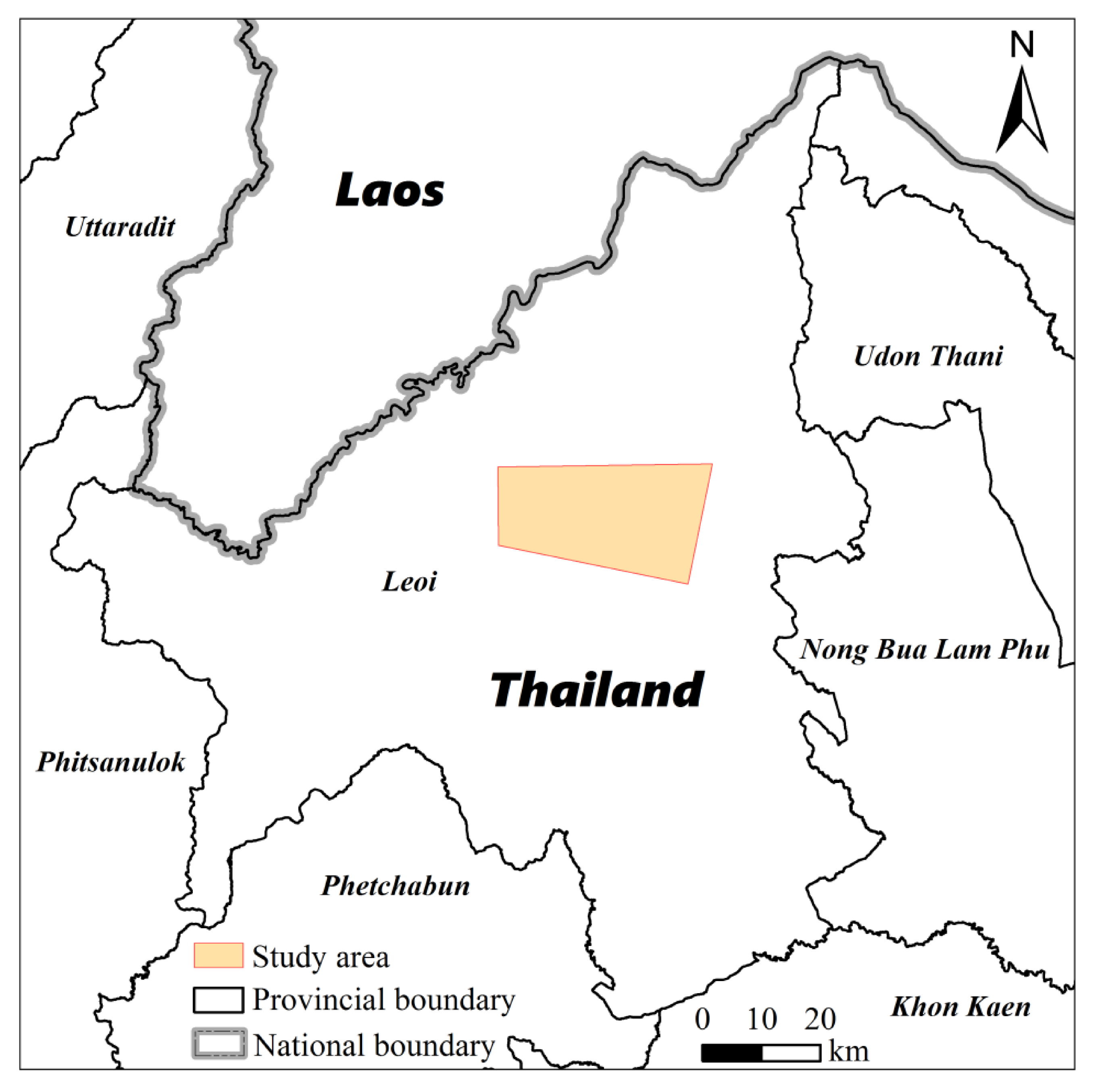
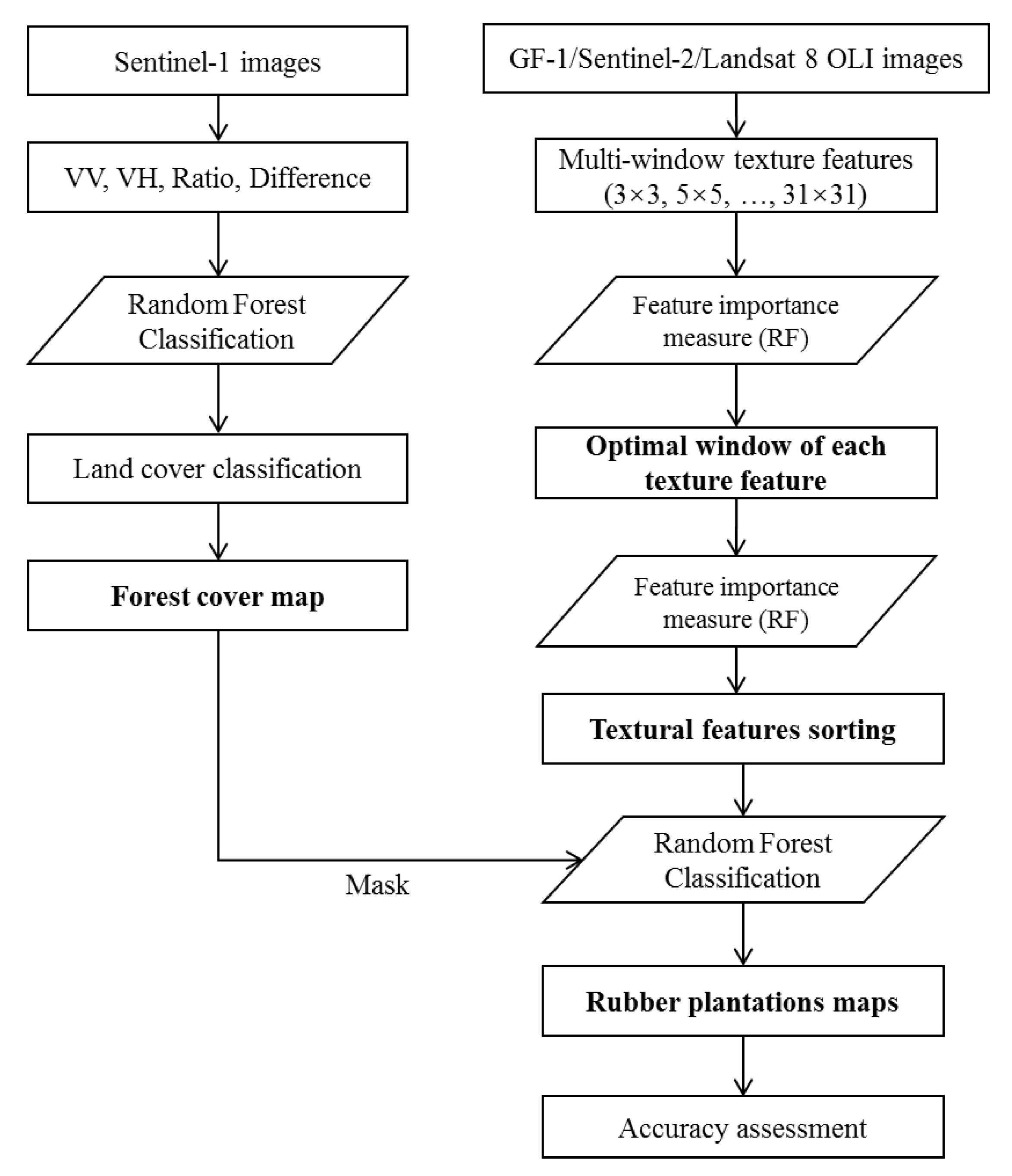
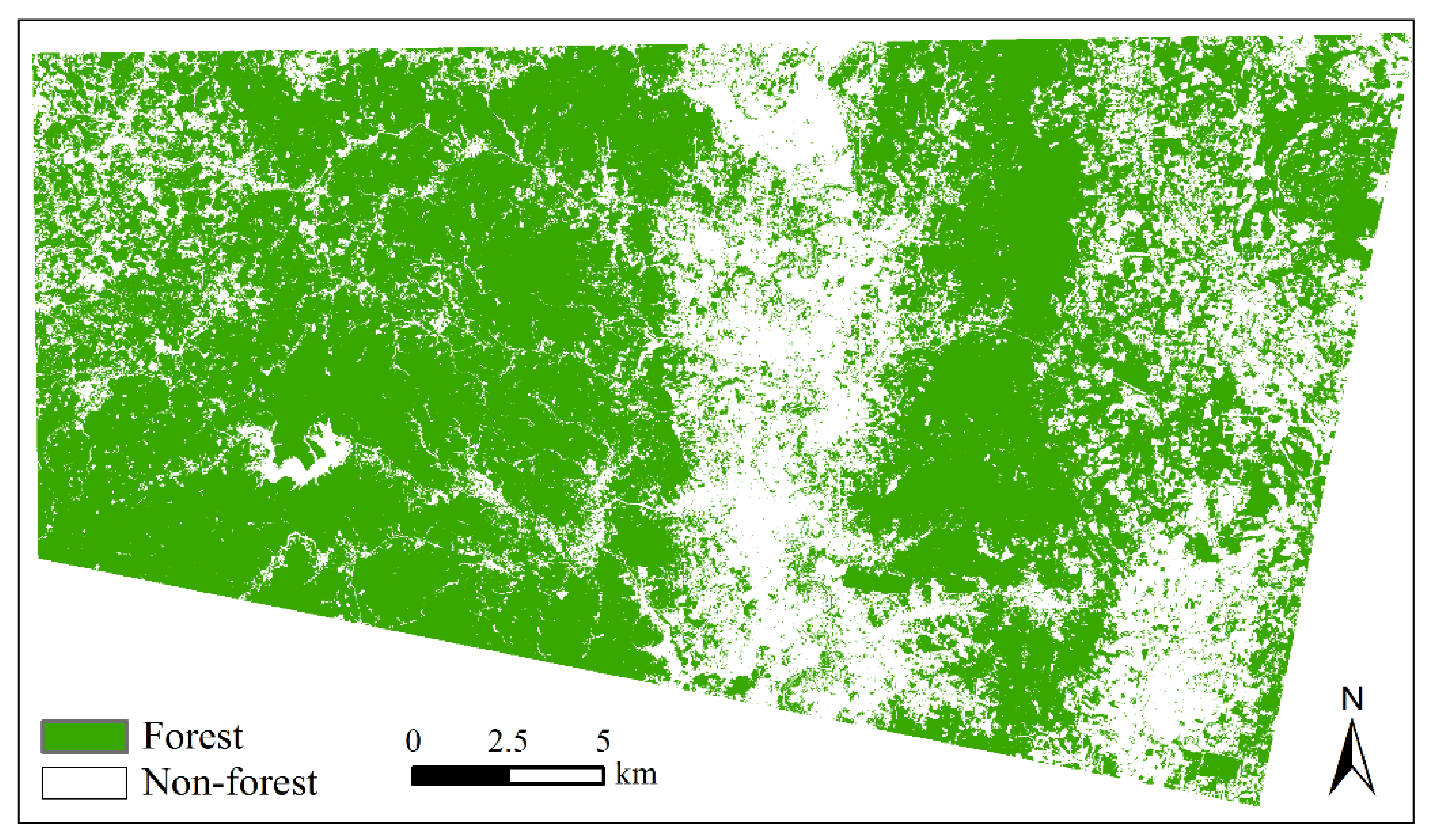
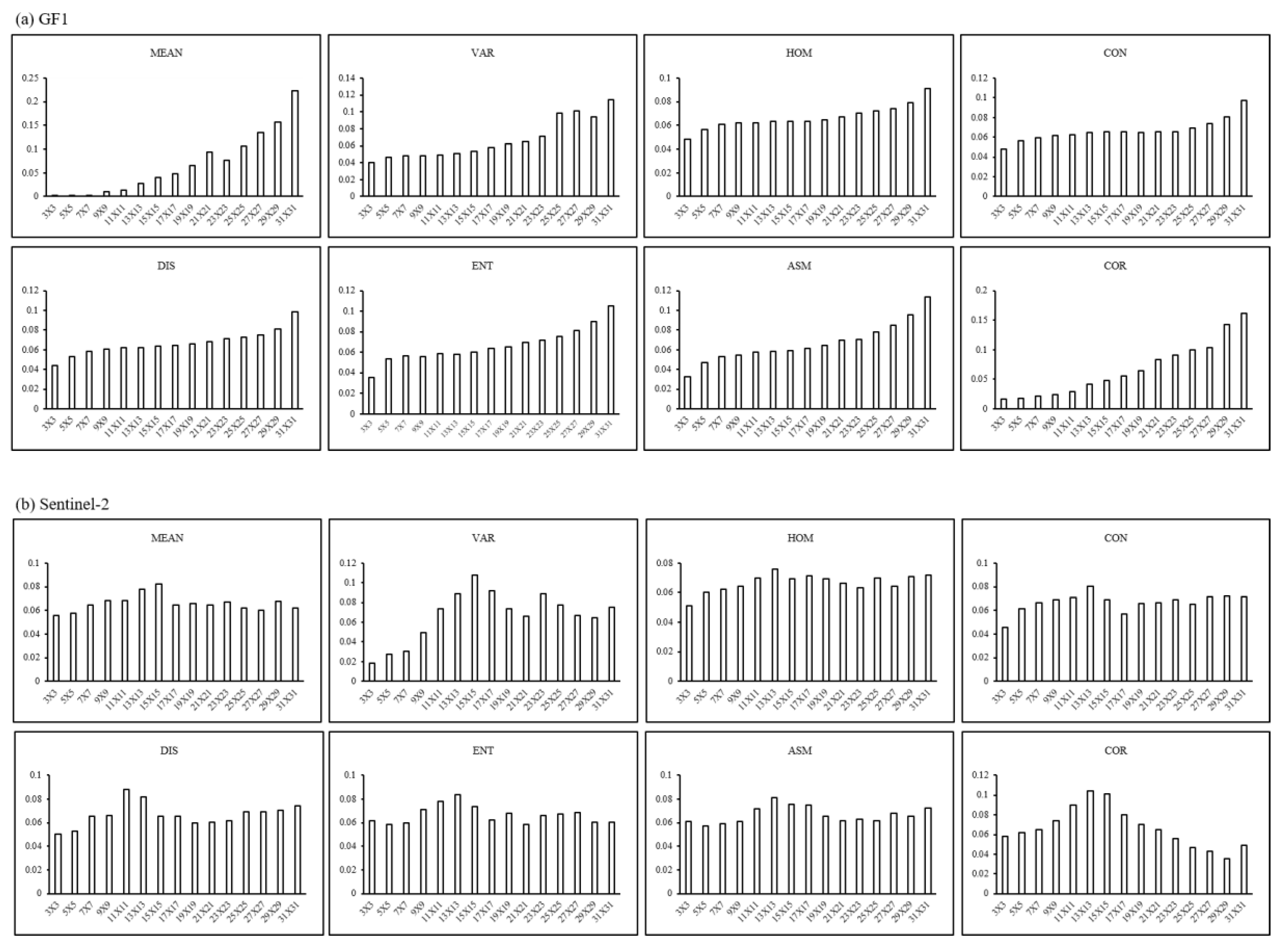
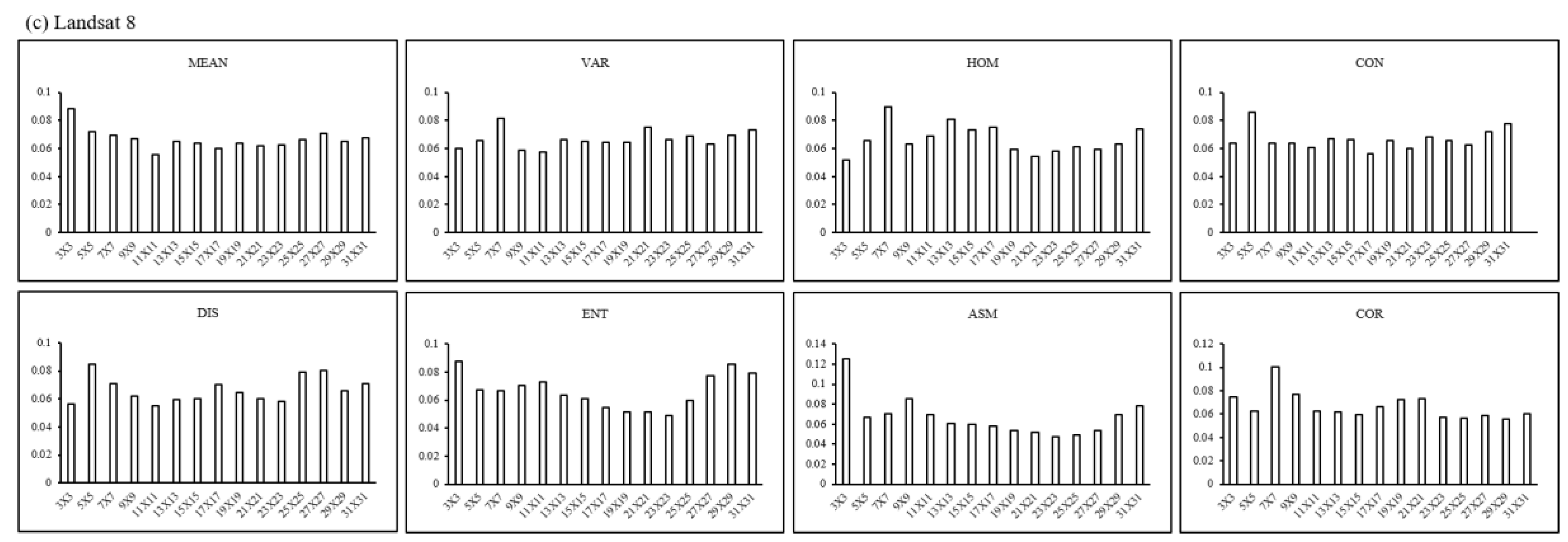

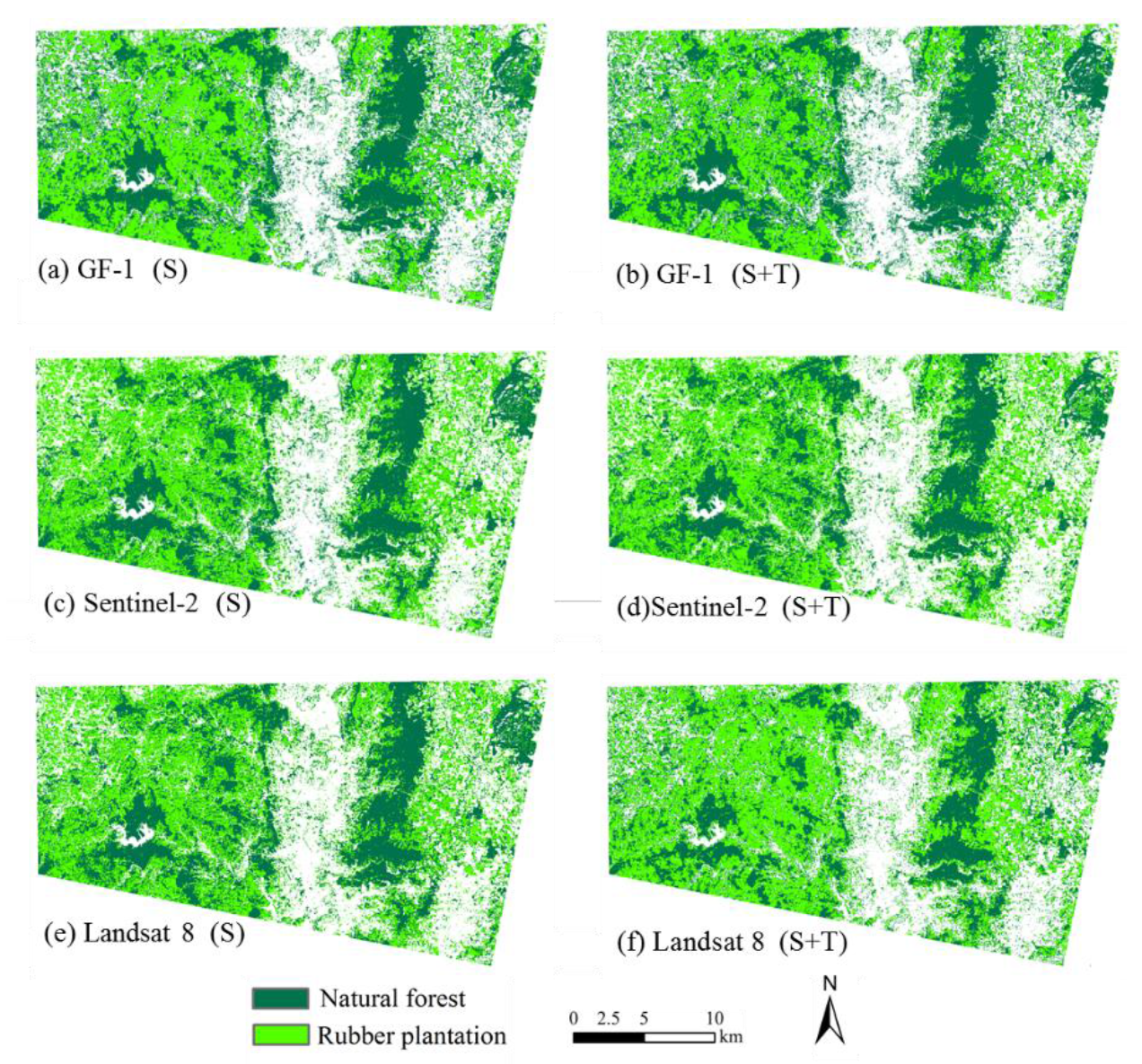
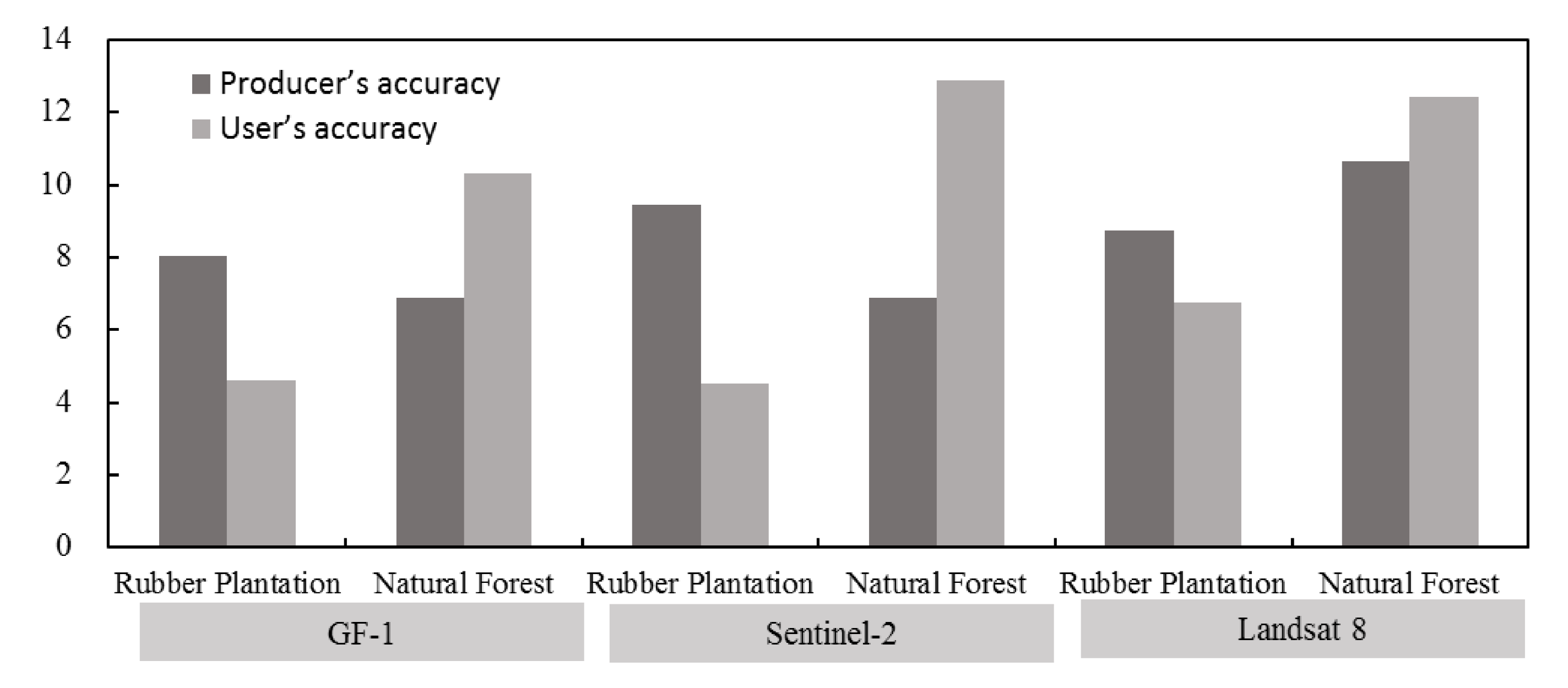
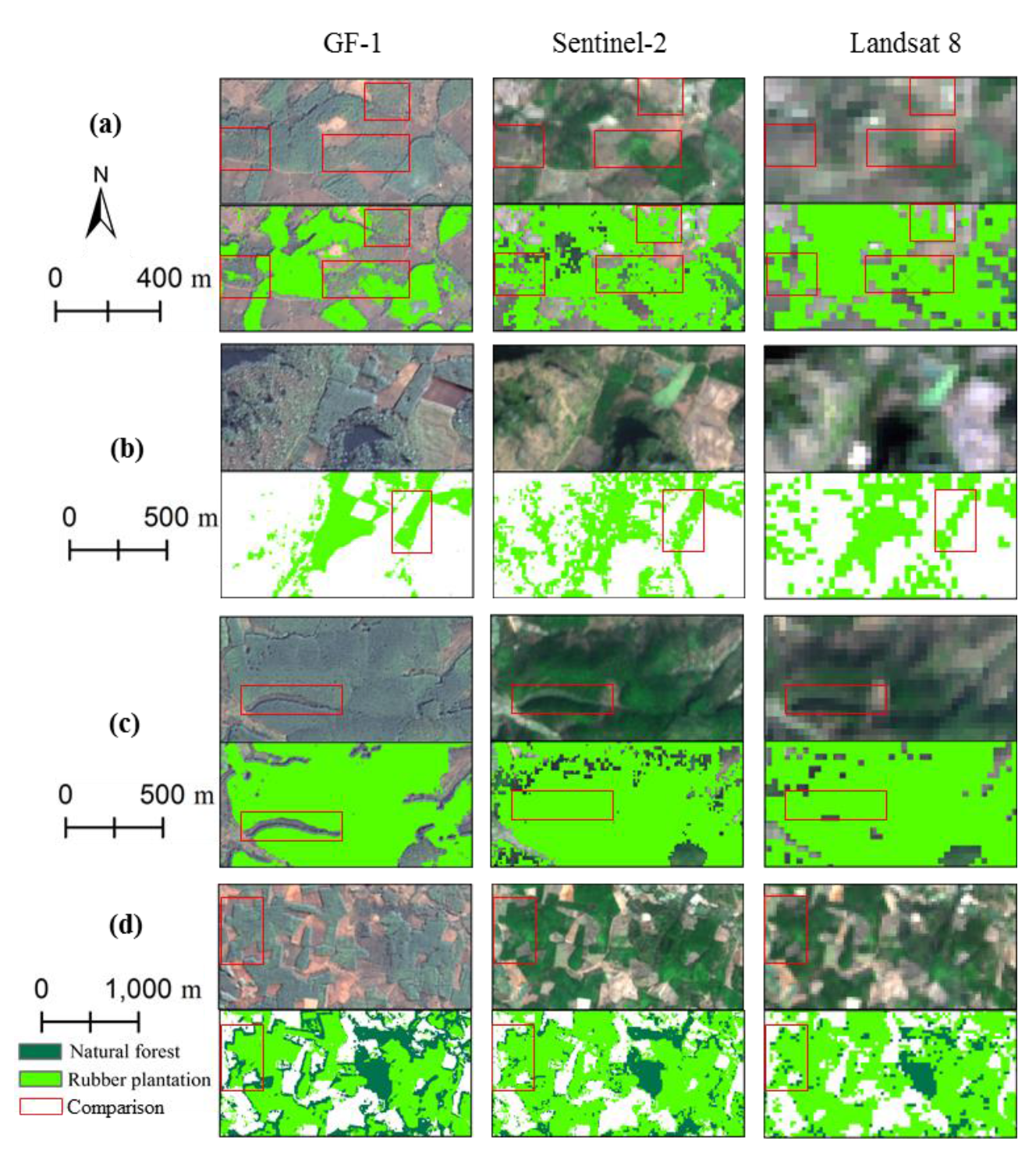
| Sensor Name | Sensor Type | Acquisition Date | Band | Resolution (m) |
|---|---|---|---|---|
| Sentinel-1 | C-band Radar | All throughout 2018 | VV + VH | 10 |
| Sentinel-2 | Optical | 16th February 2018 | 490–2190 nm | 10–20 |
| GF-1 | Optical | 5th March 2019 | 450–890 nm | 2–8 |
| Landsat 8 | Optical | 13th February 2018 | 450–2290 nm | 30 |
| Texture Measure | Formula | Description |
|---|---|---|
| Mean (MEAN) | MEAN represents the average brightness information in the window. It reflects the degree of texture rules. The stronger the rules, the greater the value. | |
| Variance (VAR) | VAR reflects the contour of each homogeneous region of the image and the change in gray level. When the gray level changes greatly, its value is larger. | |
| Homogeneity (HOM) | HOM is a measure of smoothness of image distribution. The more uniform the image matrix, the larger the value. | |
| Contrast (CON) | CON reflects texture thickness. The bigger the difference between adjacent pixels and gray value, the bigger the value. | |
| Dissimilarity (DIS) | DIS is similar to contrast (CON), reflecting the heterogeneity of images. | |
| Entropy (ENT) | ENT is a measure of the amount of information. The more complex the texture in the window, the greater the entropy value. | |
| Angular Second Moment (ASM) | ASM is the roughness of image texture. The finer the texture, the smaller the ASM. | |
| Correlation (COR) | COR reflects the similarity of pixels in row and column directions of the gray level co-occurrence matrix. The higher the correlation, the greater the value. |
| Class | User’s Accuracy | Producer’s Accuracy | Estimation Error 1 | Overall Accuracy | Kappa |
|---|---|---|---|---|---|
| Forest 2 | 98.24% | 96.34% | 3.66 ± 1.71% | 0.9593 | 0.8919 |
| Non-forest 3 | 89.31% | 94.67% | 5.33 ± 3.59% |
| Class | User’s Accuracy | Producer’s Accuracy | Estimation Error | Overall Accuracy | Kappa | |
|---|---|---|---|---|---|---|
| GF-1 | Rubber plantation | 92.65% | 79.37% | 20.63 ± 6.27% | 0.8271 | 0.6448 |
| Natural forest | 70.65% | 88.75% | 11.25 ± 3.66% | |||
| Sentinel-2 | Rubber plantation | 92.13% | 81.82% | 18.18 ± 5.98% | 0.8386 | 0.6639 |
| Natural forest | 72.92% | 87.50% | 12.50 ± 3.83% | |||
| Landsat 8 | Rubber plantation | 89.84% | 80.42% | 19.58 ± 6.15% | 0.8161 | 0.6162 |
| Natural forest | 70.53% | 83.75% | 16.25 ± 4.28% |
| Class | User’s Accuracy | Producer’s Accuracy | Estimation Error | Overall Accuracy | Kappa | |
|---|---|---|---|---|---|---|
| GF-1 | Rubber plantation | 97.28% | 87.41% | 12.59 ± 5.14% | 0.9036 | 0.7985 |
| Natural forest | 80.95% | 95.63% | 4.37 ± 2.37% | |||
| Sentinel-2 | Rubber plantation | 96.67% | 91.26% | 8.74 ± 4.38% | 0.9238 | 0.8379 |
| Natural forest | 85.80% | 94.38% | 5.62 ± 2.67% | |||
| Landsat 8 | Rubber plantation | 96.59% | 89.16% | 10.84 ± 4.82% | 0.9103 | 0.8108 |
| Natural forest | 82.97% | 94.38% | 5.62 ± 2.67% |
© 2020 by the authors. Licensee MDPI, Basel, Switzerland. This article is an open access article distributed under the terms and conditions of the Creative Commons Attribution (CC BY) license (http://creativecommons.org/licenses/by/4.0/).
Share and Cite
Zhang, C.; Huang, C.; Li, H.; Liu, Q.; Li, J.; Bridhikitti, A.; Liu, G. Effect of Textural Features in Remote Sensed Data on Rubber Plantation Extraction at Different Levels of Spatial Resolution. Forests 2020, 11, 399. https://doi.org/10.3390/f11040399
Zhang C, Huang C, Li H, Liu Q, Li J, Bridhikitti A, Liu G. Effect of Textural Features in Remote Sensed Data on Rubber Plantation Extraction at Different Levels of Spatial Resolution. Forests. 2020; 11(4):399. https://doi.org/10.3390/f11040399
Chicago/Turabian StyleZhang, Chenchen, Chong Huang, He Li, Qingsheng Liu, Jing Li, Arika Bridhikitti, and Gaohuan Liu. 2020. "Effect of Textural Features in Remote Sensed Data on Rubber Plantation Extraction at Different Levels of Spatial Resolution" Forests 11, no. 4: 399. https://doi.org/10.3390/f11040399





